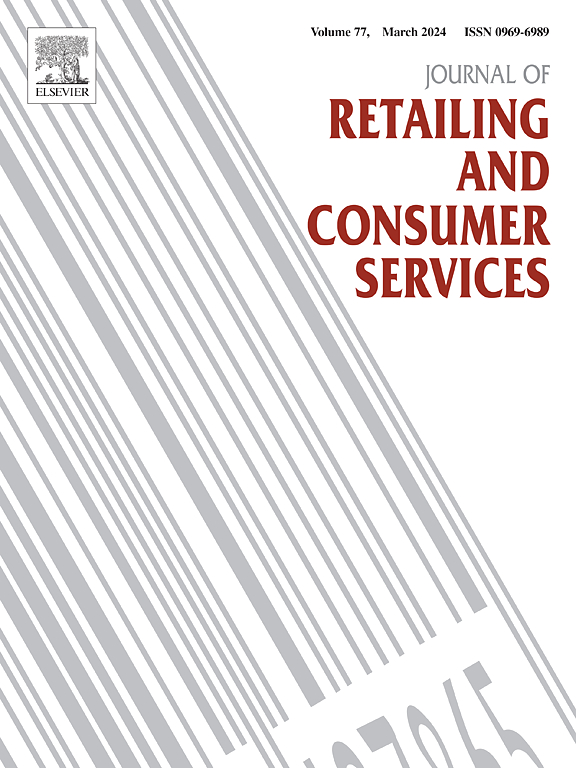当虚拟网红导致服务失败:人的相似度和美貌类型对社会心理距离和消费者意向的影响
IF 11
1区 管理学
Q1 BUSINESS
Journal of Retailing and Consumer Services
Pub Date : 2025-07-26
DOI:10.1016/j.jretconser.2025.104426
引用次数: 0
摘要
本研究考察了虚拟影响者在服务故障期间对消费者反应的影响。在解释水平理论的基础上,我们研究了两种外貌特征,特别是人的相似性(类人vs类化身)和美貌类型(典型vs独特)如何影响社会心理距离,从而影响虚拟网红服务失败后的应对行为意图。我们还探讨了服务失败严重程度和消费者归因(内部归因与外部归因)在社会心理距离与行为意图关系中的调节作用。数据收集自304名20多岁和30多岁的美国女性。结果证实,具有典型美貌的类人虚拟网红减少了社会心理距离,在服务失败后促进了更多的和解,而不是回避或报复。相比之下,具有独特美感的虚拟网红增加了社会心理距离,培养了更多的不良行为意图。此外,当SPD较低时,较不严重的服务故障引起的消费者反应较温和,包括较低的回避意愿和较高的和解意愿;然而,当SPD较高时,严重失败会加剧不良反应,包括更高的回避和更低的和解意愿。最后,消费者归因,无论他们倾向于归咎于内部还是外部线索,也调节了SPD与这三种行为意图之间的因果关系。这些发现表明,利用虚拟影响者的营销人员应该制定量身定制的恢复策略,考虑虚拟影响者的外表线索、社会心理距离、服务失败严重程度和消费者归因倾向。这项研究为拥有虚拟网红的品牌提供了可操作的指导,并加深了我们对数字时代服务失败的理解。本文章由计算机程序翻译,如有差异,请以英文原文为准。
When virtual influencers cause service failures: The impact of human likeness and beauty types on social psychological distance and consumer intentions
This study examines the impact of virtual influencers on consumer responses during service failures. Grounded in construal level theory, we investigate how two appearance characteristics, specifically human-likeness (human-like vs. avatar-like) and beauty type (typical vs. unique), affect social psychological distance and, consequently, coping behavioral intentions following virtual influencer service failures. We also explore the moderating roles of service failure severity and consumer attribution (internal vs. external) in the relationship between social psychological distance and their behavioral intentions. Data were collected from 304 U.S. women in their 20s and 30s. Results confirmed that human-like virtual influencers with typical beauty reduce social psychological distance, prompting greater reconciliation rather than avoidance or revenge after service failures. In contrast, avatar-like virtual influencers with unique beauty increase social psychological distance and foster more adverse behavioral intentions. Moreover, less severe service failures elicit milder consumer responses, including lower avoidance and higher reconciliation intentions, when SPD is lower; however, severe failures intensify adverse reactions, including higher avoidance and lower reconciliation intentions, when SPD is higher. Lastly, consumer attribution, whether they tend to blame internal or external cues, moderates the causal relationships between SPD and those three behavioral intentions as well. These findings suggest that marketers leveraging virtual influencers should develop tailored recovery strategies considering appearance cues of virtual influencers, social psychological distance, service failure severity, and consumers’ attribution tendencies. This research offers actionable guidance for brands featuring virtual influencers and deepens our understanding of digital-era service failures.
求助全文
通过发布文献求助,成功后即可免费获取论文全文。
去求助
来源期刊
CiteScore
20.40
自引率
14.40%
发文量
340
审稿时长
20 days
期刊介绍:
The Journal of Retailing and Consumer Services is a prominent publication that serves as a platform for international and interdisciplinary research and discussions in the constantly evolving fields of retailing and services studies. With a specific emphasis on consumer behavior and policy and managerial decisions, the journal aims to foster contributions from academics encompassing diverse disciplines. The primary areas covered by the journal are:
Retailing and the sale of goods
The provision of consumer services, including transportation, tourism, and leisure.

 求助内容:
求助内容: 应助结果提醒方式:
应助结果提醒方式:


